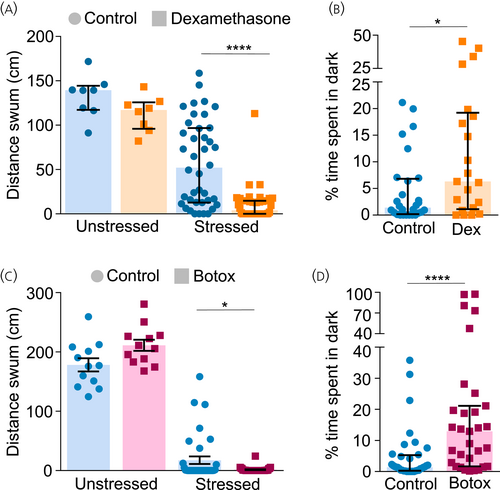Fig. 4 Altered adrenocorticotropic hormone (ACTH) levels result in impaired stress-responsive and anxiety-like behaviour. (A, C) Larvae were treated between 2–6 days post fertilization (dpf) with 35 μM dexamethasone/left untreated (A) or Tg (pomc:Gal4;UAS:BoTxLCB-GFP) were selected (C). At 6 dpf, control and treated/transgenic groups were subjected to osmotic stress by transferring to 50% artificial seawater for 20 min. Larvae were washed, transferred into individual wells of a 96-well plate, and their locomotive behaviour was recorded for 10 min to analyze the effect of osmotic challenge on behaviour. Behaviour of unstressed larvae was used as reference. Two-way analysis of variance (ANOVA) followed by Sidak's post hoc multiple comparisons test; Dexamethasone: n = 8 unstressed/32 stressed (A), Botox: n = 12 unstressed/36 stressed (C). (B, D) Larvae were treated with 35 μM dexamethasone between 4–6 dpf/maintained as control (B) or Tg(pomc:Gal4;UAS:BoTxLCB-GFP) larvae were selected (D). At 6 dpf, control and treated/transgenic larvae were introduced into the dark–light preference chamber and their behaviour was recorded for 10 min. The percentage of total time that the larvae spend in the dark zone was plotted. Mann–Whitney test, n = 28 control/21 dexamethasone (B); n = 36 control/32 Botox (D). Data presented as median ± range, *p < .05, **p < .01, ****p < .0001.
Image
Figure Caption
Acknowledgments
This image is the copyrighted work of the attributed author or publisher, and
ZFIN has permission only to display this image to its users.
Additional permissions should be obtained from the applicable author or publisher of the image.
Full text @ J. Neuroendocrinol.

